Analys
SHB Veckans Jordbrukskommentar – 22 april 2016
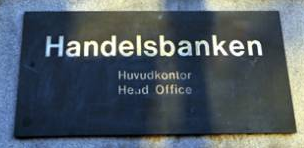
 Vete
Vete
Terminspriserna på vete i både Paris och Chicago har gått upp en hel del under veckan – för att idag igen falla tillbaka kraftigt. Tidigare uppgång är till stor del en följd av väderproblem i Sydamerika, med negativa konsekvenser för främst majs och soja – en så snabb och kraftig uppgång som följde för vete kändes dock väldigt omotiverad med rådande lagersituation och inte minst med klart goda utsikter för kommande veteskörd. Förhållandena för vetet i USA, Kanada, EU och även Ryssland och Ukraina uppges vara generellt sett väldigt goda och allt pekar i dagsläget på fortsatt överutbud av vete.
Skicket på franskt vete uppges vara väldigt gott och i nivå med förra året vid samma tid på året, dock något längre kommen i utveckling. Amerikanskt höstvete väntas avkasta 12 procent mer än förra årets låga hektaravkastning – vilket väger upp för en omkring 8 procent lägre areal såvida inte vädret ställer till det.
Visst finns det skäl att oro för soja och majs avspeglar sig även i utvecklingen för vetepriset men utan nya problem, oftast väderrelaterade, kopplade mer specifikt till vete är vi fortsatt i en tro om att priset på terminer för ny skörd kommer falla en hel del – terminer med längre löptid handlas med stor riskpremie, ett påslag som rimligen bör försvinna/minska efter hand som tiden löper utan problem. Vete på termin MATIF december 2016 går nu att sälja för omkring EUR 170 (SEK 1.550) per ton). För er som vill prissäkra er skörd men inte låsa priset med terminer, för att kunna ta del av en eventuell prisuppgång, erbjuder vi även optionshandel – hör gärna av er om det är av intresse.
Raps
Rapspriserna i Paris har fortsatt stabilt uppåt – till stor del en följd av stigande priser på soja med skördehämmande regn i Sydamerika. Även högre pris på råolja har gett stöd till uppgången. USDA spår en ökning av EU:s raps-produktion med 350.000 ton till 22,4 miljoner ton – delvis som följd av ökade arealer i östra Europa samt en väldigt gynnsam vinter. Dock väntas ändå tillgången av raps bli klart begränsad då viktiga exportländer väntas få lägre produktion – inte minst Ukraina som haft en del problem med torrt väder. Vi tror att rapsen kommer stå sig starkt framöver i förhållande till flera övriga grödor även om potentialen för uppgång känns begränsad nu utan nya väderproblem. Raps november 2016 handlas nu kring EUR 370 (SEK 3.385) per ton.
Majs
Majspriserna i Chicago har stigit något under veckan men backar tillbaka idag. En del regn har fördröjt sådden i USA men torrt väder kommande dagar väntas sätt fart på fältarbetet igen. Regnandet i Argentina ser ut att avta kommande dagar men återkomma igen i slutet av nästa vecka, vilket lär fördröja skördearbetet ytterligare något. Endast dryga 20 procent av skörden uppges vara avklarad, klart under det normala, dock är avkastningsnivån hög. Utsikterna för sådd i USA ser för tillfället väldigt goda ut vädermässigt – fortsätter den utvecklingen tror vi att priserna kommer falla tillbaka igen inom kort.
Sojabönor
Priserna i Chicago på sojabönor har stigit en hel del den senaste tiden, främst som följd av väldigt rikligt med nederbörd i Argentina – vilket både fördröjer skörden och drar ned avkastningen. Flera lokala analytiker spår nu en argentinsk sojaskörd omkring 5-10 procent lägre jämfört med tidigare prognoser. Omkring 16 procent av skörden uppges nu vara avklarad, långt efter förra årets 46 procent samma tid på året. Kommande dagar ser något torrare ut men en del prognoser lovar därefter regn igen. Väderutvecklingen för skörd i Argentina framöver blir viktig att följa och snart startar även sådden i USA – förvänta er en fortsatt volatil och väderstyrd marknad.
[box]SHB Jordbrukskommentar är producerat av Handelsbanken och publiceras i samarbete och med tillstånd på Råvarumarknaden.se[/box]
Ansvarsbegränsning
Detta material är producerat av Svenska Handelsbanken AB (publ) i fortsättningen kallad Handelsbanken. De som arbetar med innehållet är inte analytiker och materialet är inte oberoende investeringsanalys. Innehållet är uteslutande avsett för kunder i Sverige. Syftet är att ge en allmän information till Handelsbankens kunder och utgör inte ett personligt investeringsråd eller en personlig rekommendation. Informationen ska inte ensamt utgöra underlag för investeringsbeslut. Kunder bör inhämta råd från sina rådgivare och basera sina investeringsbeslut utifrån egen erfarenhet.
Informationen i materialet kan ändras och också avvika från de åsikter som uttrycks i oberoende investeringsanalyser från Handelsbanken. Informationen grundar sig på allmänt tillgänglig information och är hämtad från källor som bedöms som tillförlitliga, men riktigheten kan inte garanteras och informationen kan vara ofullständig eller nedkortad. Ingen del av förslaget får reproduceras eller distribueras till någon annan person utan att Handelsbanken dessförinnan lämnat sitt skriftliga medgivande. Handelsbanken ansvarar inte för att materialet används på ett sätt som strider mot förbudet mot vidarebefordran eller offentliggörs i strid med bankens regler.
Analys
More weakness and lower price levels ahead, but the world won’t drown in oil in 2026

Some rebound but not much. Brent crude rebounded 1.5% yesterday to $65.47/b. This morning it is inching 0.2% up to $65.6/b. The lowest close last week was on Thursday at $64.11/b.

The curve structure is almost as week as it was before the weekend. The rebound we now have gotten post the message from OPEC+ over the weekend is to a large degree a rebound along the curve rather than much strengthening at the front-end of the curve. That part of the curve structure is almost as weak as it was last Thursday.
We are still on a weakening path. The message from OPEC+ over the weekend was we are still on a weakening path with rising supply from the group. It is just not as rapidly weakening as was feared ahead of the weekend when a quota hike of 500 kb/d/mth for November was discussed.
The Brent curve is on its way to full contango with Brent dipping into the $50ies/b. Thus the ongoing weakening we have had in the crude curve since the start of the year, and especially since early June, will continue until the Brent crude oil forward curve is in full contango along with visibly rising US and OECD oil inventories. The front-month Brent contract will then flip down towards the $60/b-line and below into the $50ies/b.
At what point will OPEC+ turn to cuts? The big question then becomes: When will OPEC+ turn around to make some cuts? At what (price) point will they choose to stabilize the market? Because for sure they will. Higher oil inventories, some more shedding of drilling rigs in US shale and Brent into the 50ies somewhere is probably where the group will step in.
There is nothing we have seen from the group so far which indicates that they will close their eyes, let the world drown in oil and the oil price crash to $40/b or below.
The message from OPEC+ is also about balance and stability. The world won’t drown in oil in 2026. The message from the group as far as we manage to interpret it is twofold: 1) Taking back market share which requires a lower price for non-OPEC+ to back off a bit, and 2) Oil market stability and balance. It is not just about 1. Thus fretting about how we are all going to drown in oil in 2026 is totally off the mark by just focusing on point 1.
When to buy cal 2026? Before Christmas when Brent hits $55/b and before OPEC+ holds its last meeting of the year which is likely to be in early December.
Brent crude oil prices have rebounded a bit along the forward curve. Not much strengthening in the structure of the curve. The front-end backwardation is not much stronger today than on its weakest level so far this year which was on Thursday last week.
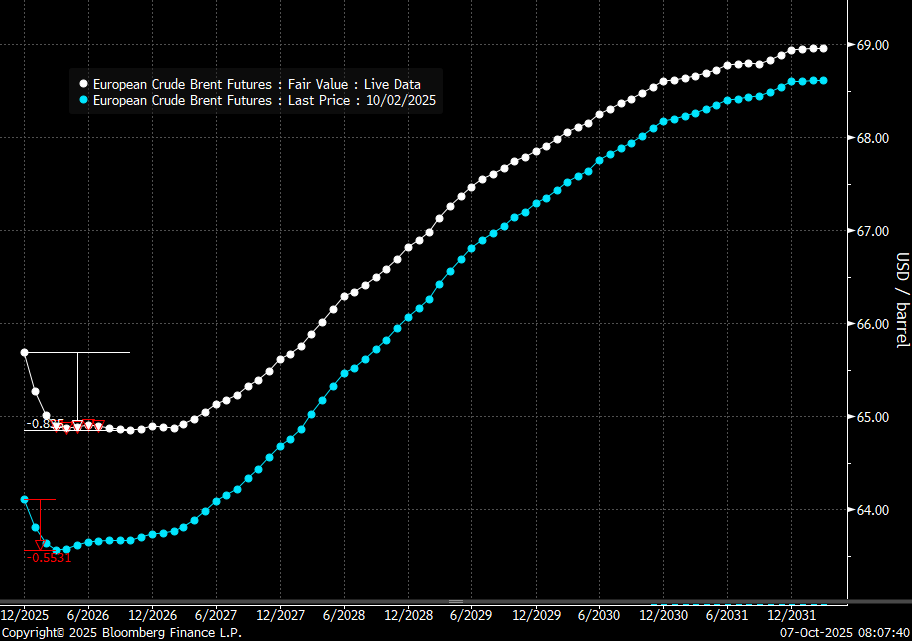
The front-end backwardation fell to its weakest level so far this year on Thursday last week. A slight pickup yesterday and today, but still very close to the weakest year to date. More oil from OPEC+ in the coming months and softer demand and rising inventories. We are heading for yet softer levels.
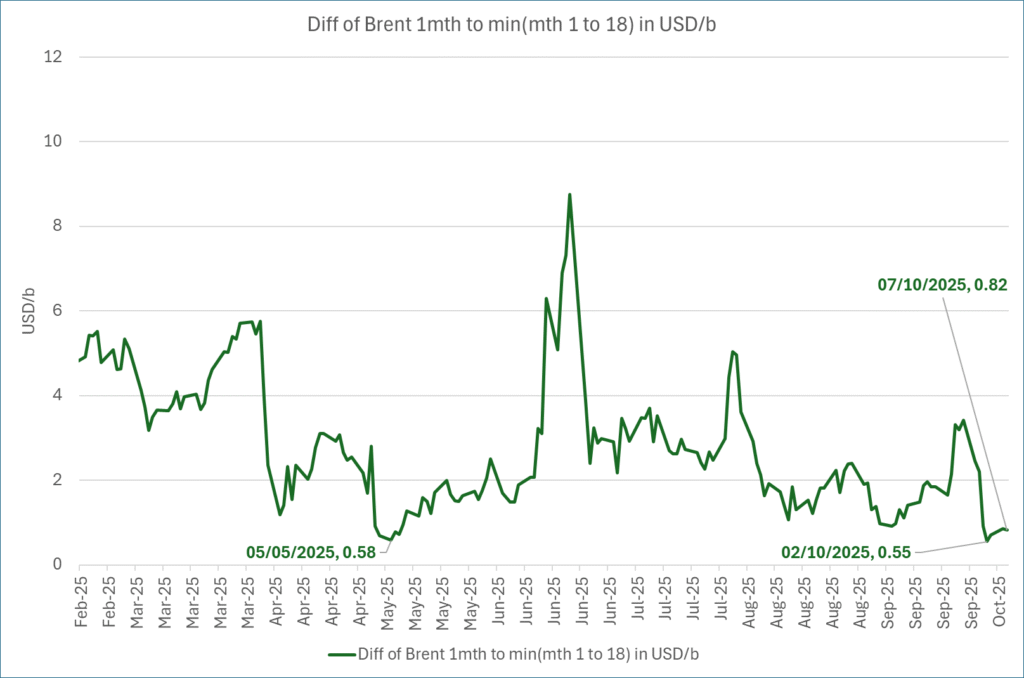
Analys
A sharp weakening at the core of the oil market: The Dubai curve

Down to the lowest since early May. Brent crude has fallen sharply the latest four days. It closed at USD 64.11/b yesterday which is the lowest since early May. It is staging a 1.3% rebound this morning along with gains in both equities and industrial metals with an added touch of support from a softer USD on top.

What stands out the most to us this week is the collapse in the Dubai one to three months time-spread.
Dubai is medium sour crude. OPEC+ is in general medium sour crude production. Asian refineries are predominantly designed to process medium sour crude. So Dubai is the real measure of the balance between OPEC+ holding back or not versus Asian oil demand for consumption and stock building.
A sharp weakening of the front-end of the Dubai curve. The front-end of the Dubai crude curve has been holding out very solidly throughout this summer while the front-end of the Brent and WTI curves have been steadily softening. But the strength in the Dubai curve in our view was carrying the crude oil market in general. A source of strength in the crude oil market. The core of the strength.
The now finally sharp decline of the front-end of the Dubai crude curve is thus a strong shift. Weakness in the Dubai crude marker is weakness in the core of the oil market. The core which has helped to hold the oil market elevated.
Facts supports the weakening. Add in facts of Iraq lifting production from Kurdistan through Turkey. Saudi Arabia lifting production to 10 mb/d in September (normal production level) and lifting exports as well as domestic demand for oil for power for air con is fading along with summer heat. Add also in counter seasonal rise in US crude and product stocks last week. US oil stocks usually decline by 1.3 mb/week this time of year. Last week they instead rose 6.4 mb/week (+7.2 mb if including SPR). Total US commercial oil stocks are now only 2.1 mb below the 2015-19 seasonal average. US oil stocks normally decline from now to Christmas. If they instead continue to rise, then it will be strongly counter seasonal rise and will create a very strong bearish pressure on oil prices.
Will OPEC+ lift its voluntary quotas by zero, 137 kb/d, 500 kb/d or 1.5 mb/d? On Sunday of course OPEC+ will decide on how much to unwind of the remaining 1.5 mb/d of voluntary quotas for November. Will it be 137 kb/d yet again as for October? Will it be 500 kb/d as was talked about earlier this week? Or will it be a full unwind in one go of 1.5 mb/d? We think most likely now it will be at least 500 kb/d and possibly a full unwind. We discussed this in a not earlier this week: ”500 kb/d of voluntary quotas in October. But a full unwind of 1.5 mb/d”
The strength in the front-end of the Dubai curve held out through summer while Brent and WTI curve structures weakened steadily. That core strength helped to keep flat crude oil prices elevated close to the 70-line. Now also the Dubai curve has given in.
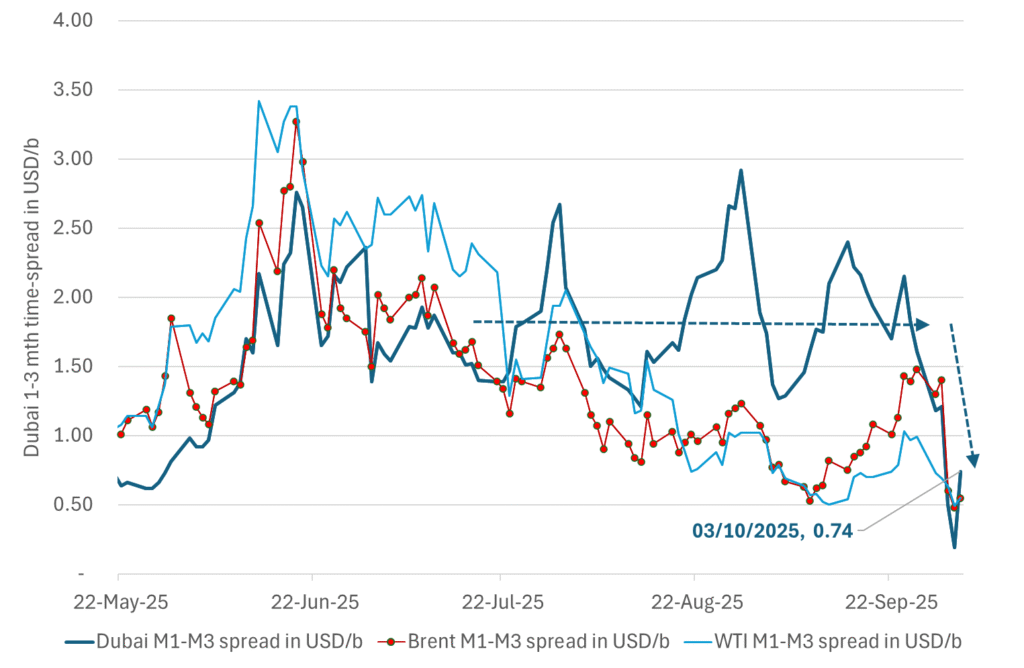
Brent crude oil forward curves
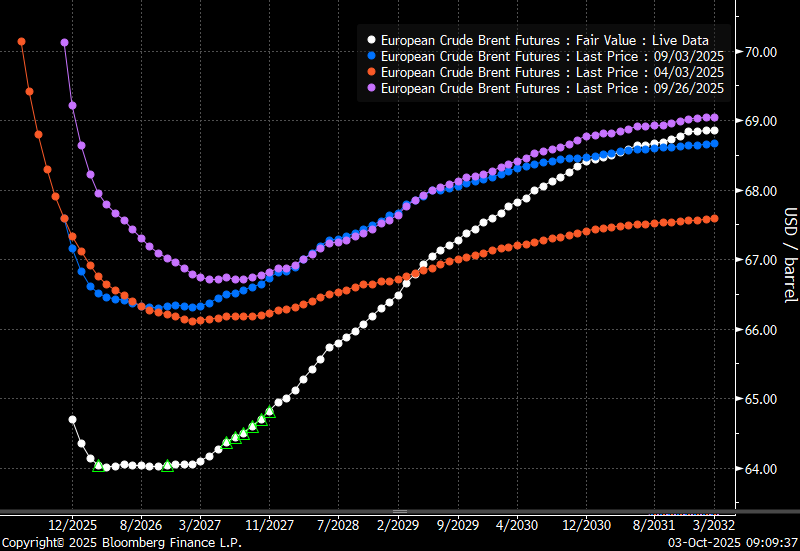
Total US commercial stocks now close to normal. Counter seasonal rise last week. Rest of year?
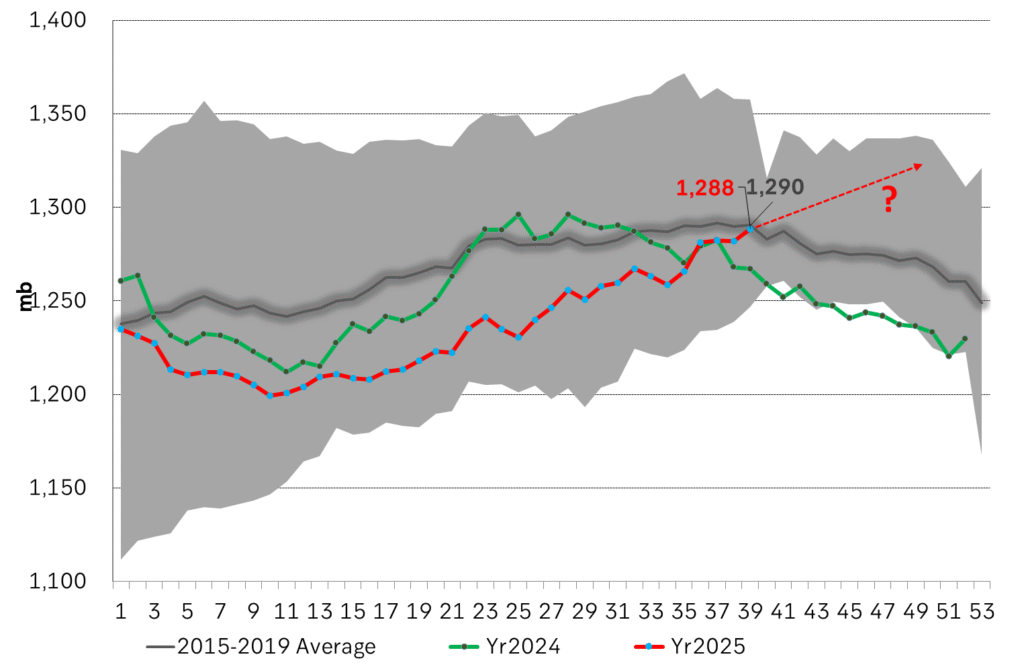
Total US crude and product stocks on a steady trend higher.
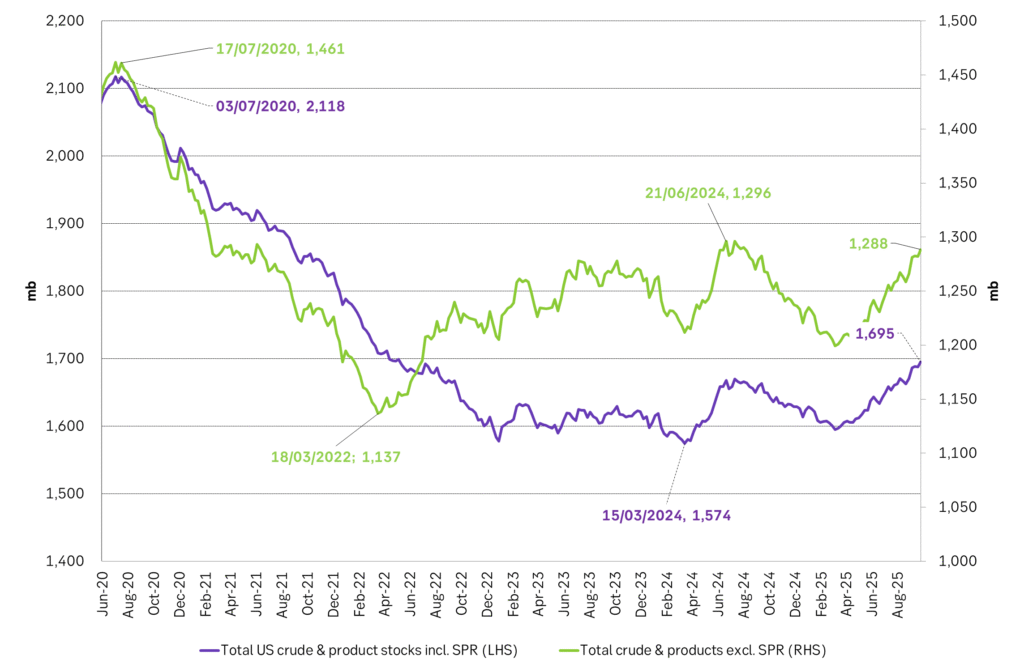
Analys
OPEC+ will likely unwind 500 kb/d of voluntary quotas in October. But a full unwind of 1.5 mb/d in one go could be in the cards

Down to mid-60ies as Iraq lifts production while Saudi may be tired of voluntary cut frugality. The Brent December contract dropped 1.6% yesterday to USD 66.03/b. This morning it is down another 0.3% to USD 65.8/b. The drop in the price came on the back of the combined news that Iraq has resumed 190 kb/d of production in Kurdistan with exports through Turkey while OPEC+ delegates send signals that the group will unwind the remaining 1.65 mb/d (less the 137 kb/d in October) of voluntary cuts at a pace of 500 kb/d per month pace.

Signals of accelerated unwind and Iraqi increase may be connected. Russia, Kazakhstan and Iraq were main offenders versus the voluntary quotas they had agreed to follow. Russia had a production ’debt’ (cumulative overproduction versus quota) of close to 90 mb in March this year while Kazakhstan had a ’debt’ of about 60 mb and the same for Iraq. This apparently made Saudi Arabia angry this spring. Why should Saudi Arabia hold back if the other voluntary cutters were just freeriding? Thus the sudden rapid unwinding of voluntary cuts. That is at least one angle of explanations for the accelerated unwinding.
If the offenders with production debts then refrained from lifting production as the voluntary cuts were rapidly unwinded, then they could ’pay back’ their ’debts’ as they would under-produce versus the new and steadily higher quotas.
Forget about Kazakhstan. Its production was just too far above the quotas with no hope that the country would hold back production due to cross-ownership of oil assets by international oil companies. But Russia and Iraq should be able to do it.
Iraqi cumulative overproduction versus quotas could reach 85-90 mb in October. Iraq has however steadily continued to overproduce by 3-5 mb per month. In July its new and gradually higher quota came close to equal with a cumulative overproduction of only 0.6 mb that month. In August again however its production had an overshoot of 100 kb/d or 3.1 mb for the month. Its cumulative production debt had then risen to close to 80 mb. We don’t know for September yet. But looking at October we now know that its production will likely average close to 4.5 mb/d due to the revival of 190 kb/d of production in Kurdistan. Its quota however will only be 4.24 mb/d. Its overproduction in October will thus likely be around 250 kb/d above its quota with its production debt rising another 7-8 mb to a total of close to 90 mb.
Again, why should Saudi Arabia be frugal while Iraq is freeriding. Better to get rid of the voluntary quotas as quickly as possible and then start all over with clean sheets.
Unwinding the remaining 1.513 mb/d in one go in October? If OPEC+ unwinds the remaining 1.513 mb/d of voluntary cuts in one big go in October, then Iraq’s quota will be around 4.4 mb/d for October versus its likely production of close to 4.5 mb/d for the coming month..
OPEC+ should thus unwind the remaining 1.513 mb/d (1.65 – 0.137 mb/d) in one go for October in order for the quota of Iraq to be able to keep track with Iraq’s actual production increase.
October 5 will show how it plays out. But a quota unwind of at least 500 kb/d for Oct seems likely. An overall increase of at least 500 kb/d in the voluntary quota for October looks likely. But it could be the whole 1.513 mb/d in one go. If the increase in the quota is ’only’ 500 kb/d then Iraqi cumulative production will still rise by 5.7 mb to a total of 85 mb in October.
Iraqi production debt versus quotas will likely rise by 5.7 mb in October if OPEC+ only lifts the overall quota by 500 kb/d in October. Here assuming historical production debt did not rise in September. That Iraq lifts its production by 190 kb/d in October to 4.47 mb/d (August level + 190 kb/d) and that OPEC+ unwinds 500 kb/d of the remining quotas in October when they decide on this on 5 October.
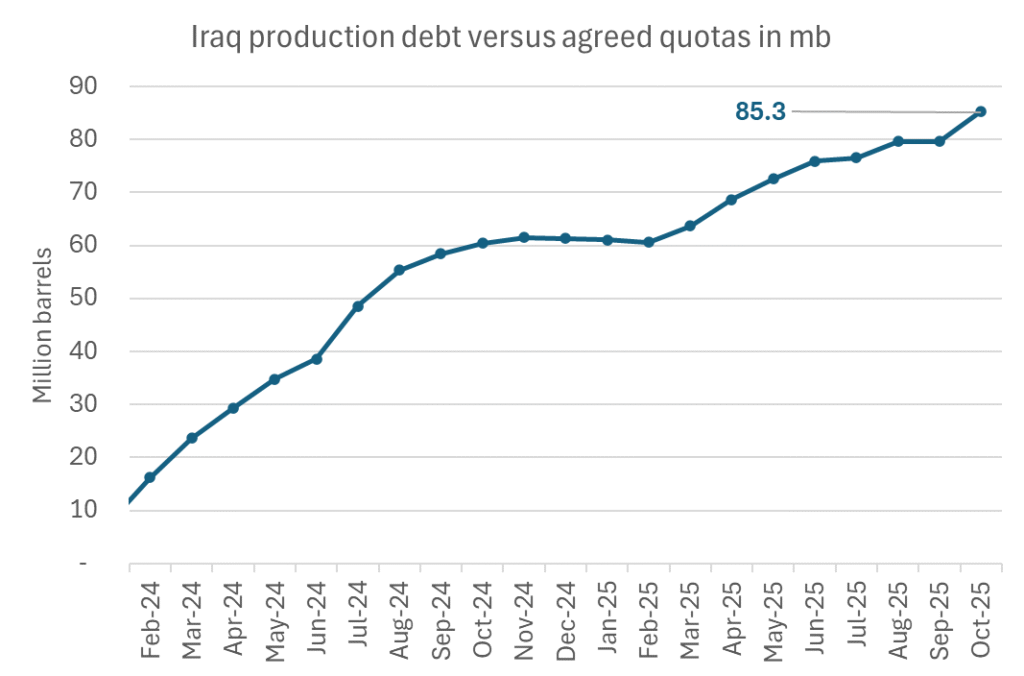
-

 Nyheter4 veckor sedan
Nyheter4 veckor sedanKinas elproduktion slog nytt rekord i augusti, vilket även kolkraft gjorde
-
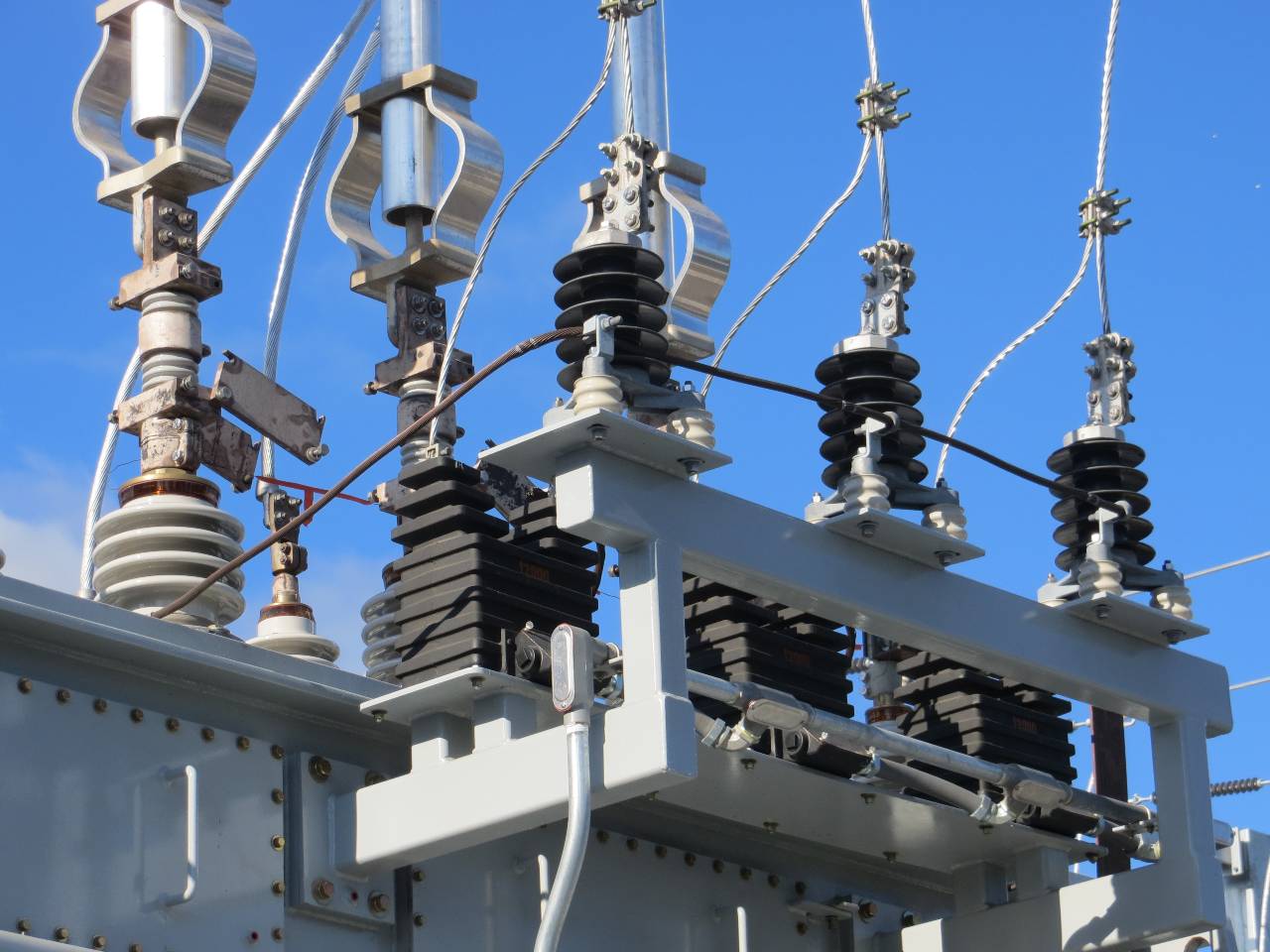
 Nyheter4 veckor sedan
Nyheter4 veckor sedanTyskland har så höga elpriser att företag inte har råd att använda elektricitet
-

 Nyheter3 veckor sedan
Nyheter3 veckor sedanOPEC+ missar produktionsmål, stöder oljepriserna
-

 Nyheter3 veckor sedan
Nyheter3 veckor sedanEtt samtal om guld, olja, fjärrvärme och förnybar energi
-

 Analys4 veckor sedan
Analys4 veckor sedanBrent crude ticks higher on tension, but market structure stays soft
-

 Analys3 veckor sedan
Analys3 veckor sedanAre Ukraine’s attacks on Russian energy infrastructure working?
-

 Nyheter2 veckor sedan
Nyheter2 veckor sedanGuld nära 4000 USD och silver 50 USD, därför kan de fortsätta stiga
-

 Nyheter3 veckor sedan
Nyheter3 veckor sedanGuldpriset uppe på nya höjder, nu 3750 USD











